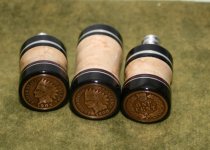Joint protectors are cheap insurance
Cheap insurance, in my opinion, and sorta like cue jewelry/accessories if you want to see it that way. The only way moisture gets into a cue is through the end grain of the wood at the joint and shaft ends....everything else is sealed. If you drop your butt on the pin, you're probably going to have to replace it.
I agree. It's cheap insurance.
1. While the "keeping dirt out" idea may be dubious when you consider that that's what the cue case is for
(unless the liner material inside is prone to lots of pill balls or something, or the inside is really dirty with chalk residue because you don't take the time to wipe the cue tip before storing it in your case), the idea of protecting the
pin while IN the case has some merit. For example, unless the cue butt fits snugly inside the case and is well-held and protected, there is going to be "slop" where the butt moves around slightly. Drop your case (or have it fall over), and the pin can be bent if it hits the lid in just the right way (e.g. on a slight-ish angle due to the "slop" in the case -- don't forget you have the entire weight of the butt behind that pin that gives it momentum). The purists are obviously going to say, "well bonehead, then don't drop your case or leave it where it can get kicked over!" And that's obviously a very shallow way of looking at it. Accidents *DO* happen, when you least expect it. I saw a player stumble down a flight of stairs, and with the more pressing matter that he got hurt while doing so (broke a couple of ribs), all his cues were ruined when the pins punched through the lid of the case, and were bent because the case was still falling down the rest of the stairs.
2. The joint protectors are also good as "handles" to help get the cue butt and shaft out of the case (I store mine with joint protectors "up" on both in my case), if the case slots happen to be deep.
3. Additionally, the joint protectors help to identify which cue you want to take out of your case, if the pins are exactly the same on some/all of them (I'm a Radial pin guy).
Now, having said all that, should the OP be "worried" that he left his joint protectors behind at the pool hall? Heck no. His cues will be FINE -- even long-term -- as long as he doesn't have a severe dropping accident with the case which could bend the pin(s).
I certainly don't look at joint protectors as being a "useless prophylactic for the obsessive compulsive" as some are making out here. They are cheap insurance, and they work -- albeit the cue/case has to go through some SERIOUS abuse before you see or reap the value of that insurance.
Hope this helps,
-Sean
